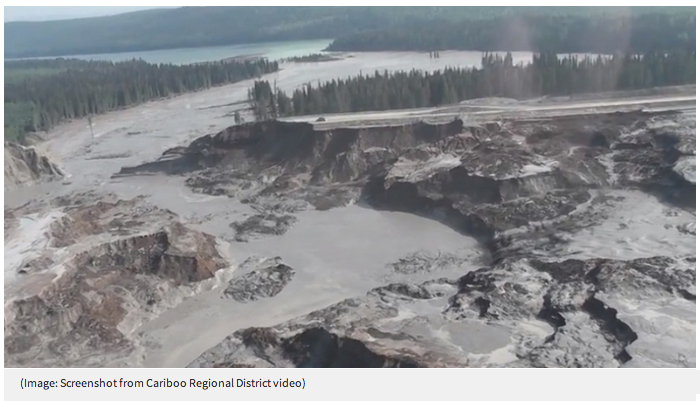‘Massive Environmental Disaster’ in Canada as Toxic Tailing Pond Floods Waterways
Water ban put in place as a tailing pond gives way and tens of millions of gallons of waste course through area rivers and lakes
by Deirdre Fulton
CommonDreams
A middle-of-the-night breach of the tailings pond for an open-pit copper and gold mine in British Columbia sent a massive volume of toxic waste into several nearby waterways on Monday, leading authorities to issue a water-use ban.
Slurry from Mount Polley Mine near Likely, B.C. breached the earthen dam around 3:45 am on Monday, with hundreds of millions of gallons — equivalent to 2,000 Olympic-sized swimming pools, according to Canada’s Global News — gushing into Quesnel Lake, Cariboo Creek, Hazeltine Creek and Polley Lake. An estimated 300 homes, plus visitors and campers, are affected by the ban on drinking and bathing in the area’s water.
Chief Anne Louie of the Williams Lake Indian band told the National Post the breach was a “massive environmental disaster.”
With salmon runs currently making their way to their spawning grounds, “Our people are at the river side wondering if their vital food source is safe to eat,” said Garry John, aboriginal activist and member of the board of directors of the Council of Canadians, in a press release.
The Canadian media company QMI Agency reports:
Federal data on the project show the company significantly increased its on-site storage of toxins such as arsenic, mercury and lead in the past two years.
Environment Canada’s data on Imperial Metal’s mine tailings show mercury compounds, a neurotoxin that can cause degenerative disease, ramped up from 435 kilograms in 2012 to 3,114 kg last year — a seven-fold increase.
Likewise, levels of the deadly poison arsenic more than quadrupled to 406,122 kg last year.
Local experts say they raised concerns about such a breach years ago. “We held discussions with the mine staff related to the potential of this situation occurring,” Chief Louie told thePost. “We have a report that we worked on a couple of years ago,” she added, referring to an independent review by an environmental consulting firm completed in 2011. The report suggested additional monitoring and emergency contingency plans were in order.
Imperial Metals, which also operates a gold mine in Nevada, said Tuesday morning that the dam had been stabilized. In a statement, the company said: “Exact quantities of water and tailings discharged have yet to be determined. The tailings are alkaline with an average ph of 8.5 and are not acid generating.”
But Ramsey Hart, the Canada programs director for MiningWatch Canada, noted that toxic heavy metals, which settle at the bottom of rivers and lakes, are difficult to clean up. “You can’t release that amount of toxic metals into ecosystems without having long-term repercussions,” Hart told QMI Agency. “If they’re able to clean some of it up that would be helpful, but they’ll never be able to clean it all up — those metals don’t go anywhere.”
The breach is further evidence that such mining projects should be vigorously opposed, said Leila Darwish, the Council of Canadians’ Pacific Regional Organizer:
These companies are gambling with our drinking water, our health and the environment. While mining companies like Imperial Metals make massive profits for 25-30 years, these projects are putting entire water systems and communities at risk. Are these massive mines really worth the risk?
The following video, from the Cariboo Regional District, shows the extent of the damage:
